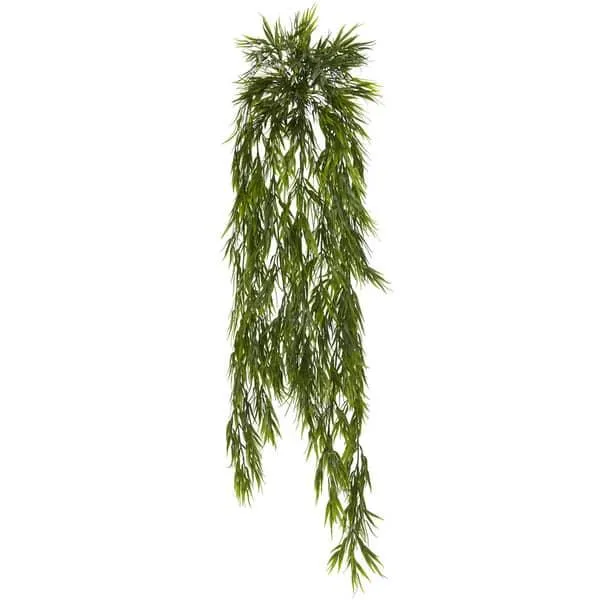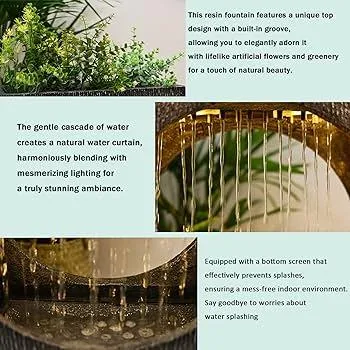Everything You Need to Know About Cascading Faux Plants
Whether you’re looking to add some green to your home without the hassle of real plants, or need flora that can withstand low-light conditions, cascading faux plants are a great option. In this article, I’ll cover all the bases on these artificial hanging plants – from different types to care tips tostyling ideas. By the end, you’ll have all the info you need to choose the perfect faux foliage for your space.
What Are Cascading Faux Plants?
Cascading faux plants, also called trailing plants, feature long vines or stems that flow over the edges of their containers for a lush, flowing look. They’re made to appear as if they’re spilling beautifully out of hanging baskets or pedestals. Some common cascading plant varieties include ivy, English ivy, pothos, spider plants, succulents, and more. These faux plants come in various textures, from thin realistic vines to thick lush foliage.
Material Types
Cascading faux plants can be made from different materials, each with their own pros and cons:
- Plastic: The most common material. Durable but may look less realistic up close. Best for low-maintenance.
- Polyester: Soft, flexible strands for a very realistic look and feel. Less durable than plastic.
- Silk: Ultra realistic with fine details but higher priced. Delicate so needs careful handling.
In general, plastic is best for high-traffic areas while polyester and silk work well for display pieces where you want maximum realism.
Care and Maintenance
The great thing about faux plants versus real ones is they require virtually no care! Just an occasional dusting will keep them looking their best. Some tips:
- Vacuum lightly with the upholstery attachment to remove dust.
- Use a small, soft brush to gently remove any debris from slender stems and leaves.
- Spot clean with a damp cloth if any spills occur.
- Store out of direct light when not in use to prevent fading.
The material will determine how long a cascading faux plant lasts – plastic may endure for decades with little care while silk or polyester need more delicate handling. Overall, very low maintenance!
Styling and Arrangement Ideas
From my experience styling with faux plants, they can be used in countless creative ways to liven up any space. Here are some ideas to get you started:

Hanging Baskets
As the name implies, cascading faux plants are perfect for hanging baskets. Use full plants shaping over the edges or mix trailing vines with filler foliage. Mount on walls, beams, or patio fences.
Tabletop Foliage
Create a lush centerpiece by placing a planter overflowing with trails of ivy on a table or mantle. Arrange shorter vines in glass votives too for a more compact look.
Shelves and Nooks
Tuck trailing plants into shelves, cubbies, or other recessed areas. Train vines over the edges for an instant privacy screen or room divider.
Combining Textures
Don’t be afraid to mix thin ivy vines with fuller tropicals like ferns or succulents for visual interest. Layer textures for depth.
Play with placements too – spiraling vines up columns, draping from hanging pots, even winding through irrigation systems or tree branches for full-bodied vignettes.
In summary, faux plants are basically like real plants without limitations. Get creative and have fun styling cascading versions indoors and out!
FAQs
Here are answers to some common questions people have when considering cascading faux plants:

Are they high maintenance? No way – they require almost no upkeep. Just an occasional dusting is basically it.
How long do they last? Plastic varieties can endure for decades or more with light care. Softer materials like silk need more gentle handling but still offer years of visual enjoyment.
Can they withstand outdoor conditions? Yes, faux plants are very weather resistant. Mount them in covered patios, under eaves, or bring in during very rainy seasons.
Do animals or kids pose a risk? Generally no, as they’re not seen as food sources. Just be aware of any sharp fronds if young kids pet them.
Are they easy to clean? Yup, just dust or gently wipe spills. The materials mean no pruning or repotting like real flora.
How realistic do they look? Advances in manufacturing have made faux plants extremely convincing to the eye. Examine textures closely to gauge realism level.
Hope this helps provide all the info needed for anyone considering cascading faux trailing plants! Please feel free to ask if any other questions come up.

Final Thoughts
In conclusion – as someone who’s used both real and faux plants in interiorscaping, I gotta say cascading faux varieties are kind of amazing. They provide an instant sense of lush greenery without any of the intensive work associated with real plants. Basically zero maintenance, zero worries about light/watering needs, and they last for like ever with just light dusting. It’s like getting the beauty of plants without any of the responsibilities! Whether you want full baskets spilling over or thin vines trailing intricately, there’s honestly no better faux plant option in my opinion. Even up close, the new realistic textures are stunning – you’d never know it wasn’t the real deal. Highly recommended for any home or space that wants the aesthetic and visual appeal of plants without the tasks. Hope you found this guide helpful for choosing the perfect cascading faux plants for you!
Choosing the Right Faux Plants for Cascading Designs
| Plant | Size | Material | Care | Best For |
|---|---|---|---|---|
| English Ivy | Small to Large | Polyester | Dust Weekly | Shelves, Stairs |
| Pothos | Small to Medium | Polyester | Dust Monthly | Shelves, Stairs |
| Spider Plant | Small | Polyester | Dust Monthly | Shelves, Stairs |
| Wax Plant | Small to Large | Polyester | Dust Weekly | Shelves, Stairs, Railings |
| Tradescantia | Small | Polyester | Dust Monthly | Shelves, Stairs |
FAQ
-
What are cascading faux plants?
Cascade plants are artificial plants that seem real but aren’t. They’re called cascading plants because they’re meant to look like the way real climbing vines or hanging plants fall over the sides of pots. These fake plants alike basically try to mimic how real ones can cascade downwards.
-
How long do they last?
Faux cascading plants will endure for quite a while if cared for properly. While not as long-living as the genuine article, they’ll serve you well for a number of years with a tiny bit of upkeep. Though they’re not actual living things, keeping them clean and out of direct sunlight helps them maintain their realistic appearance for quite a stretch. They’ll serve you well before needing replacement.
-
What types are available?
There are a wide range of simulated cascading plants to choose from. The most typical ones resemble english ivy, wisteria, or spider plants. However, you can also get faux options made to look like hanging hearts, hanging baskets of flowers, or trailing succulents. The selections have become quite diverse, practically allowing you to have any vine or hanging plant without a green thumb.
-
How much do they cost?
Prices can vary significantly depending on the size and variety of cascading faux plant you want. Often you can find basic ivy or wisteria lookalikes for around 20 dollars. However, larger or more unique designs might go for 50 dollars or higher. When calculating the price, definitely look at the plant’s width and length to get an idea of how much fabric and details went into crafting it. Overall they provide quite reasonable value for their good looks and years of usage.
-
Can they be outside?
While very realistic-looking, faux cascading plants aren’t meant for outdoor use generally. The materials they’re crafted from like plastics and fabrics aren’t rated to withstand weather and sunlight over the long haul. Leaving them outside could cause them to fade, become brittle, or mold rather quickly in comparison to real plants. It’s best to keep simulated vines and hangers in shaded or indoor areas for optimal “life”. However, some more rugged faux ivies may withstand patios if not in direct sun rays.
-
How do you care for them?
Caring for faux cascading plants is quite simple. Dust them occasionally with a soft cloth. Wipe off any lint or debris buildup using a damp cloth as needed. Avoid getting them soaked as the materials may degrade. Gently fluff leaves and stems to maintain a natural flow. Reposition if parts curl awkwardly. Most importantly, don’t leave them in high heat or direct sun, since that can damage appearance faster. With small efforts like these, they’ll look fantastic for years!

-
Are they hypoallergenic?
Yes, fake cascading plants are completely hypoallergenic since they are not real botanical materials. This can be quite attractive to people sensitive to real pollen, molds or other allergens. The artificial plants won’t trigger any sneezing or itching like living ones potentially could. They provide a low-maintenance, allergen-free way to add lush visual interest anywhere in the home or office. So if allergies are a concern, faux versions definitely make sense.
